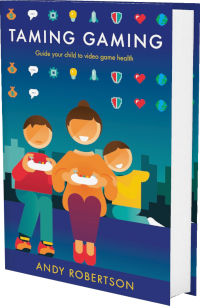 Android
Android iOS
iOS Mac
Mac Switch
Switch Wii
Wii Wii U
Wii U PC
PC PS4
PS4 PS5
PS5 Xbox One
Xbox One Xbox X|S
Xbox X|SWe've documented 33 accessibility features for Ancestree, including Playable Without Hearing, No Pressured Communication, No Pressured Reveals, No Close Inspection Disadvantage and Outline Key Elements. Its accessibility is strongest in Reading and Getting Started but it also has features in Physical, Difficulty, Visual and Audio to reduce unintended barriers.
This report is created with input from accessibility experts and the player community to help people find games that have the accessibility features they require. Once you have found potential games on the database, there are excellent specialist accessibility sites that offer in-depth reviews to guide your purchasing decisions.
External examiner, Ken Franklin, first checked Ancestree accessibility a year ago. It was re-examined by Ken Franklin and updated a year ago.
 Accessibility Notes
Accessibility Notes
You can access the How to Play video, the digital rulebook, and tules in French, German, and Spanish on the Calliopegames webpage for the game.
 Game Details
Game Details
Release Date: 01/01/2017
Skill Rating: 6+ year-olds
Players: 2-6
Genres: Sequencing, Strategy and Collecting
Accessibility: 33 features
Components: Placeables, Score Board and Tokens
Developer: Calliope Games (@CalliopeGames)
Costs: Purchase cost
 Difficulty
Difficulty
We've documented 4 accessibility features for Difficulty in Ancestree which deal with how you can adjust the challenge of play.
Difficulty Options
No Memorisation Advantage: You don’t need to memorise and recall the state of the game, cards played, sequences and resources to play the game well. Players who are able to do this more easily are not at an advantage.
No Deceit Advantage: No game mechanic where players need to deceive each other to progress. This includes bluffing and lying.
No Colour Advantage: Game can be played without colour-blindness being a barrier to performance.
No Mathematics Advantage: Game can be played effectively without doing more than simple counting. It doesn't require calculations or working with large numbers.
 Getting Started
Getting Started
We've documented 7 accessibility features for Getting Started in Ancestree which deal with what support is offered to get started with the game.
Assistance Getting Started
These features aid your play of the game in terms of cognitive load on learning controls, dealing with pressure and coping with the environment and challenges.
Clear Manual: Game provides a manual that breaks play into number sections, groups information sensibly and uses illustrative pictures.
Electronic Version of Manual: A free online version of the manual provided by the publisher.
Getting Started Video: Game provides a tutorial video to get you started. This video must include subtitles and offer real examples of play.
Assistance Progressing
These features aid your progress through the game offering different ways of managing your pieces and progression.
Play Order Tokens (Or play order doesn’t change): Where player order impacts the game or there are multiple play phases the game provides a means of keeping track of this. Includes provision of play order tokens or use of piece/board orientation.
Reaction-Time Not Critical: Individual game actions don’t need quick reactions. This means you don't need to quickly respond to events in the game or other players.
Low Pressure: Decisions aren’t time-limited so you can take your time with each action.
Low Impact: Decisions are low impact. If you get something wrong, you can still make up for it and/or progress another way.
Similar Games With More Accessibility Features for Getting Started
If you want to play Ancestree, but it doesn't offer the Getting Started accessibility features you require, this similar game extends the Getting Started accessibility:
- ShipShape (8 Getting Started Features)
 Reading
Reading
We've documented 8 accessibility features for Reading in Ancestree which deal with how much reading or listening comprehension is required, how well the game provides accessible text.
Reading Level
How much reading is required to play the game and how complex the language is.
No Text: No text or numbers in the game at all. This means the game is language independent.
Necessary Text Visibility
How clear are the required text or numbers to play the game.
Large Clear Text on Board (Or no text required): Text or numbers are large and clear font at least 8mm tall (22pt) on the board and any other elements that are at a distance to the player.
Large Clear Text on Cards (Or no text required): Text or numbers are large and clear 5mm tall (14pt) on the pieces that you can hold close to read.
High Contrast Text (Or no text required): Text or number colours contrasts to the background. The text in instructions and other information is presented in high contrast ideally with a solid background.
QR Code For Text (Or no text required): QR codes that trigger voiced versions of the text to be played audibly.
Primary and Secondary Text Distinguishable (Or no text required): Game separates non-essential flavour text from essential gameplay text, to ease comprehension. Includes games that don't have flavour text.
Information Orientation: You don’t have to read text, numbers or symbols upside-down to play the game effectively.
Clear Icons: Icons are used to simply communicate and highlight important graphical elements related to gameplay. This assumes good contrast and generally familiar symbols.
 Physical
Physical
We've documented 7 accessibility features for Physical in Ancestree which deal with how you interact with the game components and how accommodating these are of different requirements.
Pieces
How the game components accommodate interactions through touch, shape, texture and colour.
No Non-Standard Dice (Or No Dice): The game uses standard numerical dice, doesn’t need dice to play or ensures dice are readable by touch.
No Paper Money: The game doesn’t use paper money.
Cards
How the game assists interaction, manipulation and management of game cards.
Limited Hand Management: You don’t need to hold more than 8 cards in your hand. This includes games with larger hands that require minimal in-hand card management.
No Excessive Card Shuffling: You don’t need to shuffle the deck of cards more than twice per total play of the game. This wouldn’t include games like Poker.
No Right-Handed Advantage: Cards don't position key information in only top-left corners that favours right-handed in-hand card arrangements.
Placement
How the game assists interaction, manipulation, management and placement of game pieces.
Player Components Not Shared: Key components are not shared so you can organise them as best suits your needs. Keeping them close to you. Organising them in useful groupings.
No Fiddly Placement: No movement or manipulation of small pieces or cards in limited space on a board or other location.
 Visual
Visual
We've documented 4 accessibility features for Visual in Ancestree which deal with how well the game offers visual clarity and adjustments to accommodate visual needs.
Printed Visibility
How well the art on (and design of) components support a range of visual needs.
Colour Blind Friendly Design: Game prioritises the use of colour blind friendly palettes. This eases distinguishing elements of the game where colour is used. Ensure colour blind supporting graphics can be easily described or verbalised.
Double-Coding Colour: Colour is not the only way to distinguish elements. This includes games that make use of texture, shapes, symbols or other visual differentiation, to supplement colour information.
Component Identifiability
How easy it is to see and identify the components you need to work with to play the game.
Outline Key Elements: Game uses a highly distinctive visual silhouette for essential elements required to play the game. This may be from the shape of game elements or by applying a bold outline or backing colour. It may also be clear text if that is the only pertinent information
No Close Inspection Disadvantage: If necessary, players can inspect similar pieces to distinguish them without time limit or risk of leaking gameplay intention.
Similar Games With More Accessibility Features for Visual
If you want to play Ancestree, but it doesn't offer the Visual accessibility features you require, this similar game extends the Visual accessibility:
- ShipShape (5 Visual Features)
 Audio
Audio
We've documented 3 accessibility features for Audio in Ancestree which deal with how the game supports player communication to meet a range of requirements.
Communication
How the game accommodates different styles of communication, particularly non-verbal.
No Pressured Reveals: No reliance on revealing actions or choices simultaneously. This ensures players who can’t perform the revealing action in real-time aren’t excluded.
No Pressured Communication: Game doesn’t require you to speak over (or louder or faster than) other players. The game includes gaps where only a single player is permitted to communicate and make their point.
Playable Without Hearing: You can play the game without the need to hear other players or sound made by game elements. Where other communication channels can be used if you have a supportive set of players, this is only included if communication can be low pressure.
Similar Games With More Accessibility Features for Audio
If you want to play Ancestree, but it doesn't offer the Audio accessibility features you require, these similar games extend the Audio accessibility:
- Carcassonne (4 Audio Features)
- Sushi Go! (4 Audio Features)
- Kingdomino (4 Audio Features)
Accessibility Report supported by VSC Rating Board, PlayabilityInitiative and accessibility contributors












